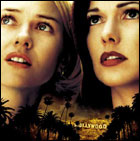Casting the Hollywood Actress as a Mythic and Surreal
Character and Interpreting her as a Figure of Modernity
“Ce qu’il y a d’admirable dans le fantastique,
c’est qu’il n’y a plus de fantastique : il n’y a plus
que le réel” (André Breton, Manifeste du Surréalisme)
[“What is admirable in the fantastic is that the fantastic
no longer exists : there endures nothing more or less
than the real.”]
“Viens-tu du ciel profond ou sors-tu de l’abîme, O
Beauté ? Ton regard, infernal et divin, Verse
confusément le bienfait et le crime...”
(Charles Baudelaire, Hymne à la Beauté, Les Fleurs du Mal)
[“Do you come from the heavens deep or do you arise from
the abyss, O Beauty ? your expression, diabolical and
divine, heds confusedly the kind deed and the criminal
act”]
|
|
| |
 |
|
|
David Lynch’s Mulholland Drive
(2001) is a terrible yet gorgeous tale of romantic
affliction. The locus of desire is Hollywood and the dominant
figure of desire is that epitome of male, universal longing,
the actress. The dark but lovely dream of Mulholland Drive
is however an extraordinary, particular tale of love, simultaneously
subversive, murderous and utopian. It is the love of one actress
for another. Female homosexual love has often been conceived
in the modern popular and poetic imagination as sensual and
dangerous and as erotic and pathological. From Charles Baudelaire’s
ode to Lesbos (Les Epaves, 1866) to Tony Scott’s
vampire flick The Hunger (1983), the figure of the
lesbian has been adorned with toxic glamour as she has also
been used, in monotonous and conventional fashion, in heterosexual
male pornography. David Lynch’s portrayal of lesbian love
in Mulholland Drive is, I suggest, influenced by such
poetic understandings of the female homosexual as an extraordinary
radical figure of perverse modernity. Lynch’s lesbian lovers
exhibit a Baudelairean paradoxical character and sensuality.
Equally, Mulholland Drive’s romantic, oneiric narrative
manifests Lynch’s love affair with surrealism. As the embodiment
of amour fou (mad love), Lynch’s sapphic love story
is perfectly surrealist. Revealing surrealist truths of romantic
love, sexuality and death are powerfully intertwined in Mulholland
Drive. The surrealist heroine of this Hollywood dream,
the actress Betty/Diane - for she is two characters - succumbs
to violent self-hatred, murder and self-destruction. Lynch’s
depiction of women and Hollywood could be effectively likened
to surrealist expressions and understandings of character,
violence and myth. Moreover, Mulholland Drive surreally
and pointedly alludes to women’s ambivalent, marvellous and
tortured role in Hollywood, unveiling the actress as the perfect
yet dehumanised woman. The powerfully iconographic yet ambiguous
history of women in Hollywood sets the stage to Lynch’s tale
of love and failure in the city of dreams. It is a leading
haunting theme of Mulholland Drive obsessing Lynch’s
dream in suggestive yet salient fashion. With a sweet and
savage post-modern playfulness, Lynch casts the actress as
a perpetually playing and deviating modern and surrealist
character and recognises her as a golden repository of myths
to be re-read and transfigured. Perhaps poetically
polemical, Mulholland Drive remains richly ambivalent.
David Lynch relates the dehumanisation of the actress as a
surreal, comic and grotesque enigma. The life of the actress
is a dreadful riddle as her love story remains a ravishing
and richly perplexing tragedy. Ultimately, the love of Hollywood
women creates a potentially utopian realm which is at once
deeply dangerous and romantic. It is a form of modern and
surreal love amorously interpreted by a post-modern director.
Finally and paradoxically, it may also be a form of love which
may be read as absolute and autonomous and as authentic and
feminine.
|